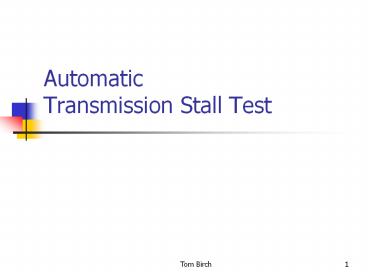Automatic Transmission Stall Test PowerPoint PPT Presentation
1 / 18
Title: Automatic Transmission Stall Test
1
Automatic Transmission Stall Test
2
Purpose
A Stall test is used to confirm transmission and
torque converter problems by placing the maximum
load on the transmission and torque converter.
3
Torque Converter Stall
Torque converter stall should not be confused
with a transmission stall test. Torque converter
stall occurs when a locked torque converter
causes the engine to stall. TC Stall can be
caused by low fluid level, faulty torque
converter controls or internal seals.
4
Preliminary Check, Fluid
Minimum
Maximum
Before stall testing, always make sure the fluid
is in good condition and at the correct level.
The fluid level should be between the minimum and
maximum points on the dipstick, and the fluid
should appear relatively clean and have a reddish
brown color.
5
Preliminary Check, Shift Linkage
With your foot firmly on the brakes, move the
shift lever through the gear positions. You
should feel the transmission internal detents as
the gear position indicator (arrow) or see the
instrument panel display the gear range.
6
Stall Test
- Always use extreme caution when stall testing a
vehicle. - Firmly set the parking brake
- Firmly apply the brake pedal.
- Use wheel blocks on at least 2 wheels.
Tachometer
Pressure Gauge
7
Stall Test Cautions
- A stall test can injure bystanders if
the vehicle operator loses control. damage the
vehicle if the vehicle operator loses control.
overheat the transmission fluid if tested too
long. burn out a clutch or band if it starts
slipping. - To prevent this, keep others
away from the front or back of the vehicle.
securely block the wheels and apply the brakes.
limit tests to five seconds for each gear
range. limit engine speed to a
little above maximum stall speed.
8
Stall Test 2
A stall test is performed by 1.
Firmly applying the brakes 2. Shifting
the transmission into gear. 3. Depressing the
throttle completely (5 seconds maximum).
4. Watching the tachometer to determine
the stall speed. 5. Releasing the
throttle for idle. 6. Recording the stall
speed. 7. Repeat the test for each of
the gear ranges.
rpm increase to stall speed
9
Stall Test 3
Note that the transmission is in Drive, the
vehicle is going 0 mph, the throttle is fully
depresses and the engine speed is stalled at
2,300 rpm. This tells us that the driving and
reaction devices for D1 are working properly.
10
STC 2
When stall testing an electronic transmission,
use caution if testing while the EPC solenoid is
disconnected. The engine can possibly send enough
torque to the transmission to cause damage.
11
Cool the fluid in the TC
Many technicians will shift the transmission into
neutral and increase the engine speed to about
1,500 rpm after each test period. This allows a
fluid exchange in the torque converter and moves
the hot fluid to the transmission cooler.
12
Interpreting the results
- Excessive engine speed during a stall test
indicates slipping clutches in the transmission. - A engine that is unable to reach stall speed
lacks power or the torque converter one way
clutch is slipping.
13
Interpreting the results
The stall speed was high only in D1. This
transmission has a slipping one-way clutch. The
same driving member is used in M1 along with a
second reaction member.
14
Interpreting the Results High Stall Speed
If all the stall speeds are higher than
specifications, the problem is caused by a
slipping apply device. Consult a clutch and band
apply chart to determine which apply device(s) is
effective in the gear range.
15
Interpreting the Results Low Stall Speed
- If all the stall speeds are lower than
specifications, the problem is caused by
either - a faulty torque converter with a slipping
one-way stator clutch. - a weak engine.
16
Fluid Pressure Test
Many technicians will attach a pressure gauge
while making a stall test. It helps determine the
cause of high stall speeds.
17
Air Test
Shop air can be applied to these ports to operate
the various hydraulic components. Excessive
leakage or no operation indicate a transmission
that needs repair.
18
AT 2
Some air nozzles use different tips that can seal
openings or reach into ports that are hard to get
to.

